 |
| Close up of paver system |
A fire truck (courtesy of the Peoria Fire Department) applied 550 gallons of water per minute over approximately 15 minutes, and the parking lot system absorbed all water with no pooling or puddling.
 |
| Fire Truck applying water at 550 gallons per minute |
According to Unilock, "Permeable pavers provide stormwater management by reducing runoff volume and rate, filtering pollutants and keeping water on site, reducing the need for retention ponds. Permeable pavers have incredible durability and can be used in a variety of climates and applications ranging from patios to parking lots. Since the earth below is warmer than ambient air temperature the snow melts and drains allowing heat to waft through the system.
You don’t have to seal or replace as often as other surfaces and repairs are straightforward, removing and replacing individual pavers. Ongoing maintenance consists of keeping debris from clogging joints by vacuuming the surface one a year."
 |
| Paver aggregate sub-base profile |
Special thanks to Unilock, Peoria Brick Company, and the Peoria Fire Department for a successful demonstration of this innovative product.
For more information use our contact form, or call us at 309-303-0919.

















